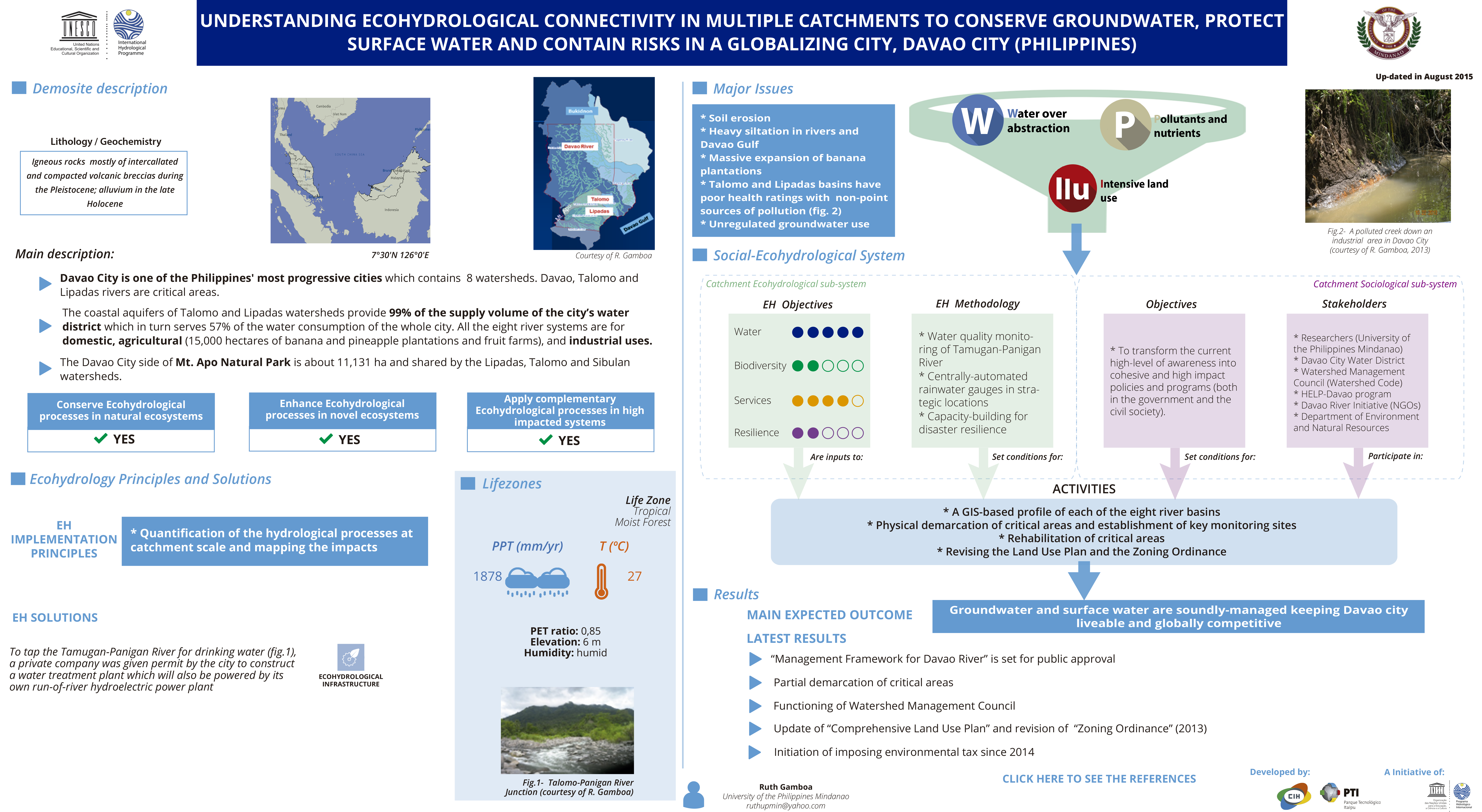UNDERSTANDING ECOHYDROLOGICAL CONNECTIVITY IN MULTIPLE CATCHMENTS TO CONSERVE GROUNDWATER, PROTECT SURFACE WATER AND CONTAIN RISKS IN A GLOBALIZING CITY, DAVAO CITY (PHILIPPINES)

Description
Location


Sketch

Information about lithology/geochemistry:
Igneous rocks mostly of intercallated and compacted volcanic breccias during the Pleistocene; alluvium in the late Holocene
Main Description
- Davao City is one of the Philippines' most progressive cities which contains 8 watersheds. Davao, Talomo and Lipadas rivers are critical areas.
- The coastal aquifers of Talomo and Lipadas watersheds provide 99% of the supply volume of the city’s water district which in turn serves 57% of the water consumption of the whole city. All the eight river systems are for domestic, agricultural (15,000 hectares of banana and pineapple plantations and fruit farms), and industrial uses.
- The Davao City side of Mt. Apo Natural Park is about 11,131 ha and shared by the Lipadas, Talomo and Sibulan watersheds.
Enhance ecohydrological processes in novel ecosystem
YES
Apply complementary Ecohydrological processes in high impacted system
YES
This table presents the different categories of ecosystem services that ecosystem can provide, divided in:
Provisioning Services are ecosystem services that describe the material or energy outputs from ecosystems. They include food, water and other resources.

Fresh water: Ecosystems play a vital role in the global hydrological cycle, as they regulate the flow and purification of water. Vegetation and forests influence the quantity of water available locally.
Regulating Services are the services that ecosystems provide by acting as regulators eg. regulating the quality of air and soil or by providing flood and disease control.
Ecosystem services "that are necessary for the production of all other ecosystem services". These include services such as nutrient recycling, primary production and soil formation.

Habitats for species: Habitats provide everything that an individual plant or animal needs to survive: food; water; and shelter. Each ecosystem provides different habitats that can be essential for a species’ lifecycle. Migratory species including birds, fish, mammals and insects all depend upon different ecosystems during their movements.
Cultural Services corresponds nonmaterial benefits people obtain from ecosystems through spiritual enrichment, cognitive development, reflection, recreation, and aesthetic experiences.

Tourism: Ecosystems and biodiversity play an important role for many kinds of tourism which in turn provides considerable economic benefits and is a vital source of income for many countries. In 2008 global earnings from tourism summed up to US$ 944 billion. Cultural and eco-tourism can also educate people about the importance of biological diversity.
Lifezones

![]()
PPT(mm/yr): 1878.0
![]()
T(ºc): 27.0
| Elevation of demosite: | 6.0 meters above sea level |
| Humidity: | Sub-Humid |
| PETr (by year): | 0.85 |
EH Principles
Quantification of the hydrological processes at catchment scale and mapping the impacts
ECOHYDROLOGY ENGINEERING SOLUTIONS
To tap the Tamugan-Panigan River for drinking water, a private company was given permit by the city to construct a water treatment plant which will also be powered by its own run-of-river hydroelectric power plant
 Ecohydrological Infrastructure
Ecohydrological Infrastructure
Major Issues
- Soil erosion
- Heavy siltation in rivers and Davao Gulf
- Massive expansion of banana plantations
- Talomo and Lipadas basins have poor health ratings with non-point sources of pollution
- Unregulated groundwater use





Expected Outcomes
Groundwater and surface water are soundly-managed keeping Davao city liveable and globally competitive
Latest Results
- “Management Framework for Davao River” is set for public approval
- Partial demarcation of critical areas
- Functioning of Watershed Management Council
- Update of “Comprehensive Land Use Plan” and revision of “Zoning Ordinance” (2013)
- Initiation of imposing environmental tax since 2014
Contacts
Ruth Gamboa
- ruthupmin@yahoo.com
- http://www.upmin.edu.ph/
- University of the Philippines Mindanao
- http://www.upmin.edu.ph/

Social ecohydrological system
EH Objectives
EH Methodology
Catchment Ecohydrological sub-system
Objectives
Stakeholders
Catchment Sociological sub-system
Activities